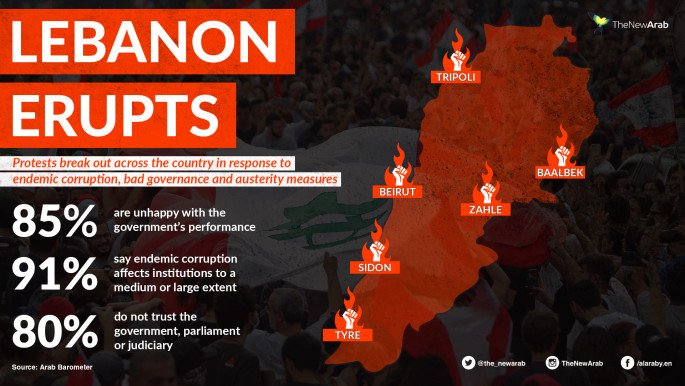
More than reform, Lebanon's system needs a complete overhaul
The WhatsApp tax turned out to be the last straw for many residents in a country that seemed to be in economic freefall.
Hariri's government had hoped to appease the protesters in promising to remedy the "waste and corruption", by offering to decrease wasteful government spending and submitting a "near zero-deficit" budget in 2020. This would entail halving government salaries and would require nearly $3.3 billion in contributions from the private banks. It would also likely have required the government to borrow more money from foreign donors.
The fact that the proposed reforms did not sit well with those who took to the streets should not come as a surprise. In the current context of Lebanon, demands for a change in the political system and the economic system are one and the same.
Some of the country's woes stem from policies and norms that have been institutionally built into the way the country has been run and managed since the civil war, including the over reliance on debt, politically motivated distribution of government resources, and endemic corruption.
After the civil war, the focus was on restoring peace rather than creating a system designed to stand the test of time. A power-sharing system based on sects was agreed in Taif in 1991. Power-sharing as a concept would spread to economic organisation in government, and as a result, government spending was not always necessarily directed towards generating value and growth in the country.
 |
Lebanon became one of the countries with the highest wealth inequality, with the top one percent of the country in possession of 25 percent of national income |  |
Instead, by allowing political parties to be allocated based on a confessional system, the country's resources were more easily captured and redistributed in a way described in a World Inequality Database study as "communal clientelism".
The same paper shows that by 2018, Lebanon became one of the countries with this highest wealth inequality, with the top one percent of the country in possession of 25 percent of national income, and the top 10 percent controlling 55 percent.
Perhaps most jarringly is the assertion that "the top 0.1 percent of the adult population, that is approximately 3,000 individuals, receives approximately the same amount of national income as the bottom 50, that is 1.5 million individuals."
Besides nearly topping the charts on inequality, Lebanon also sits third on the list of indebted countries with its total debt bill reaching 156 percent of GDP. The country has been overly reliant on debt, and the promise to reverse that and end up without a deficit in 2020 is quite optimistic.
 |
For starters, any attempts to decrease spending by removing some subsidies risks further enraging the protesters. Any attempt to increase income in the short term might entail adding additional tax burdens, which is what brought them onto the streets in the first place.
Although alarm bells over the country's economy have been ringing for the past few years, many continued with the assumption that everything in Lebanon would be fine. It is, after all a country that has repeatedly exhibited extraordinary resilience in the face of catastrophe over the past half-century.
The term "Lebanese miracle," was widely used in the 90s in reference to the country's remarkable ability to seemingly bounce back economically, after enduring a brutal civil war for 15 years, but also for its ability to outperform its neighbours, despite political and security turbulence.
So hearing Central Bank governor Riad Salame say that Lebanon was days away from an economic "collapse", should they fail to come up with a political solution quickly, was all the more jarring.
Comment: Hariri resigns, but the start of the revolution is not its end
On the surface, it might be easy to see how some came to believe in the "miraculous" nature of Lebanon's post-war economic structure.
The redevelopment of downtown Beirut was touted as a symbol of Lebanon's resurgence. It coincided with a brief boom in the 1990s. But in reality the development of downtown Beirut would sow the seeds for a host of post-war economic missteps that would help lead to the current situation.
Prime minister at the time, Rafik Hariri and others attempted to fund and run the project, with the additional aim of presenting Lebanon as a liberalised economy ripe for foreign direct investment.
 |
What they built instead was a system of enshrined corruption, built on debt and susceptible to changing circumstances of the markets outside of Lebanon |  |
What they built instead was a system of enshrined corruption, built on debt and susceptible to changing circumstances of the markets outside of Lebanon.
For example, one policy adopted by Rafik Hariri removed customs on certain imported goods, which actually helped handicap government spending due to the sizeable contribution these taxes made to fiscal spending.
Ultimately, the system is one built to exhibit certain tendencies that favour inequality and corrupt elites. If the protests are to have any long term effect, the system must be overhauled in a profound way.
Mohamed ElMeshad is a journalist and a PhD candidate at SOAS, focusing on the political economy of the media. He has worked extensively in Egypt, Bahrain, West Africa, the UK and US. Recently, he contributed to the Committee to Protect Journalists' book, Attacks on the Press (2015).
Join the conversation: @The_NewArab
Opinions expressed in this article remain those of the author and do not necessarily represent those of The New Arab, its editorial board or staff.





 Follow the Middle East's top stories in English at The New Arab on Google News
Follow the Middle East's top stories in English at The New Arab on Google News


